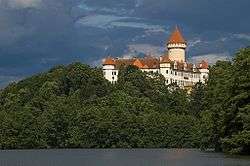Archduke Franz Ferdinand of Austria
| Archduke Franz Ferdinand | |||||
|---|---|---|---|---|---|
| Archduke of Austria-Este | |||||
 Franz Ferdinand, ca. 1914 | |||||
| Born |
18 December 1863 Graz, Austrian Empire | ||||
| Died |
28 June 1914 (aged 50) Sarajevo, Austria-Hungary (assassinated) | ||||
| Spouse | Sophie, Duchess of Hohenberg | ||||
| Issue | |||||
| |||||
| House | Habsburg-Lorraine | ||||
| Father | Archduke Karl Ludwig of Austria | ||||
| Mother | Princess Maria Annunciata of Bourbon-Two Sicilies | ||||
| Religion | Roman Catholicism | ||||
| Signature |
 | ||||

Franz Ferdinand Carl Ludwig Joseph Maria (18 December 1863 – 28 June 1914) was an Archduke of Austria-Este, Austro-Hungarian and Royal Prince of Hungary and of Bohemia and, from 1896 until his death, heir presumptive to the Austro-Hungarian throne.[1]
His assassination in Sarajevo precipitated Austria-Hungary's declaration of war against Serbia. This caused the Central Powers (including Germany and Austria-Hungary) and Serbia's allies to declare war on each other, starting World War I.[2][3][4]
Early life
Franz Ferdinand was born in Graz, Austria, the eldest son of Archduke Karl Ludwig of Austria (younger brother of Franz Joseph and Maximilian) and of his second wife, Princess Maria Annunciata of Bourbon-Two Sicilies. In 1875, when he was only eleven years old, his cousin Duke Francis V of Modena died, naming Franz Ferdinand his heir on condition that he add the name Este to his own. Franz Ferdinand thus became one of the wealthiest men in Austria.
Heir presumptive
In 1889, Franz Ferdinand's life changed dramatically. His cousin Crown Prince Rudolf committed suicide at his hunting lodge in Mayerling.[5] This left Franz Ferdinand's father, Karl Ludwig, as first in line to the throne. Karl Ludwig died of typhoid fever in 1896.[6] Henceforth, Franz Ferdinand was groomed to succeed to the throne.
Travels
Despite this burden, he did manage to find time for travel and personal pursuits, such as the trip round the world he embarked on in 1892. After visiting India he spent time hunting kangaroos and emus in Australia in 1893,[7] then travelled on to Nouméa, New Hebrides, Solomon Islands, New Guinea, Sarawak, Hong Kong and Japan.[8] After sailing across the Pacific on the RMS Empress of China from Yokohama to Vancouver[9] he crossed the United States and returned to Europe.
The Archduke and his wife visited England in the autumn of 1913, spending a week with George V and Queen Mary at Windsor Castle before going to stay for another week with the Duke of Portland at Welbeck Abbey, Nottinghamshire, where they arrived on 22 November. He attended a service at the local Catholic church in Worksop and the Duke and Archduke went game shooting on the Welbeck estate when, according to the Duke's memoirs, Men, Women and Things:
"One of the loaders fell down. This caused both barrels of the gun he was carrying to be discharged, the shot passing within a few feet of the archduke and myself. I have often wondered whether the Great War might not have been averted, or at least postponed, had the archduke met his death there and not in Sarajevo the following year."[10]
Franz Ferdinand had a fondness for trophy hunting that was excessive even by the standards of European nobility of this time.[11] In his diaries he kept track of an estimated 300,000 game kills, 5,000 of which were deer. About 100,000 trophies were on exhibit at his Bohemian castle at Konopiště[12][13] which he also stuffed with various antiquities, his other great passion.[14]
Military career
Franz Ferdinand, like most males in the ruling Habsburg line, entered the Austro-Hungarian Army at a young age. He was frequently and rapidly promoted, given the rank of lieutenant at age fourteen, captain at twenty-two, colonel at twenty-seven, and major general at thirty-one.[15] While never receiving formal staff training, he was considered eligible for command and at one point briefly led the primarily Hungarian 9th Hussar Regiment.[16] In 1898 he was given a commission "at the special disposition of His Majesty" to make inquiries into all aspects of the military services and military agencies were commanded to share their papers with him.[17]
He exerted influence on the armed forces even when he did not hold a specific command through a military chancery that produced and received documents and papers on military affairs. This was headed by Alexander Brosch von Aarenau and eventually employed a staff of sixteen.[17] His authority was reinforced in 1907 when he secured the retirement of the Emperor's confidant Friedrich von Beck-Rzikowsky as Chief of the General Staff. Beck's successor, Franz Conrad von Hötzendorf, was personally selected by Franz Ferdinard.[18]
Franz in 1913, as heir-presumptive to the elderly emperor, had been appointed inspector general of all the armed forces of Austria-Hungary (Generalinspektor der gesamten bewaffneten Macht), a position superior to that previously held by Archduke Albrecht and including presumed command in wartime.[19]
Marriage and family
In 1894 Franz Ferdinand met Countess Sophie Chotek at a ball in Prague. To be eligible to marry a member of the Imperial House of Habsburg, one had to be a member of one of the reigning or formerly reigning dynasties of Europe. The Choteks were not one of these families, although they did include among their ancestors, in the female line, princes of Baden, Hohenzollern-Hechingen, and Liechtenstein. One of Sophie's direct ancestors was Albert IV, Count of Habsburg; she was descended from Elisabeth of Habsburg, a sister of King Rudolf I of Germany. Franz Ferdinand was a descendant of King Rudolf I. Sophie was a lady-in-waiting to Archduchess Isabella, wife of Archduke Friedrich, Duke of Teschen. Franz Ferdinand began to visit Archduke Friedrich's villa in Pressburg (now Bratislava). Sophie wrote to Franz Ferdinand during his convalescence from tuberculosis on the island of Lošinj in the Adriatic. They kept their relationship a secret.[20]
Deeply in love, Franz Ferdinand refused to consider marrying anyone else. Finally, in 1899, Emperor Franz Joseph agreed to permit Franz Ferdinand to marry Sophie, on condition that the marriage would be morganatic and that their descendants would not have succession rights to the throne.[5] Sophie would not share her husband's rank, title, precedence, or privileges; as such, she would not normally appear in public beside him. She would not be allowed to ride in the royal carriage or sit in the royal box in theaters.[20]
The wedding took place on 1 July 1900, at Reichstadt (now Zákupy) in Bohemia; Franz Joseph did not attend the affair, nor did any archduke including Franz Ferdinand's brothers.[5] The only members of the imperial family who were present were Franz Ferdinand's stepmother, Princess Maria Theresa of Braganza, and her two daughters. Upon the marriage, Sophie was given the title "Princess of Hohenberg" (Fürstin von Hohenberg) with the style "Her Serene Highness" (Ihre Durchlaucht). In 1909, she was given the more senior title "Duchess of Hohenberg" (Herzogin von Hohenberg) with the style "Her Highness" (Ihre Hoheit). This raised her status considerably, but she still yielded precedence at court to all the archduchesses. Whenever a function required the couple to assemble with the other members of the imperial family, Sophie was forced to stand far down the line, separated from her husband.[20]
Franz Ferdinand's children were:
- Princess Sophie of Hohenberg (1901–1990), married Count Friedrich von Nostitz-Rieneck (1891–1973)
- Maximilian, Duke of Hohenberg (1902–1962), married Countess Elisabeth von Waldburg zu Wolfegg und Waldsee (1904–1993)
- Prince Ernst of Hohenberg (1904–1954), married Marie-Therese Wood (1910–1985)
- Stillborn son (1908), buried in Artstetten Castle, near his parents[21][22]
Character
The German historian Michael Freund described Franz Ferdinand as "a man of uninspired energy, dark in appearance and emotion, who radiated an aura of strangeness and cast a shadow of violence and recklessness ... a true personality amidst the amiable inanity that characterized Austrian society at this time."[23] As his sometime admirer Karl Kraus put it, "he was not one who would greet you ... he felt no compulsion to reach out for the unexplored region which the Viennese call their heart."[24] His relations with Emperor Franz Joseph were tense; the emperor's personal servant recalled in his memoirs that "thunder and lightning always raged when they had their discussions."[25] The commentaries and orders which the heir to the throne wrote as margin notes to the documents of the Imperial central commission for architectural conservation (where he was Protector) reveal what can be described as "choleric conservativism."[26] The Italian historian Leo Valiani provided the following description.
Francis Ferdinand was a prince of absolutist inclinations, but he had certain intellectual gifts and undoubted moral earnestness. One of his projects--though because of his impatient, suspicious, almost hysterical temperament, his commitment to it, and the methods by which he proposed to bring it about, often changed--was to consolidate the structure of the state and the authority and popularity of the Crown, on which he saw clearly that the fate of the dynasty depended, by abolishing, if not the dominance of the German Austrians, which he wished to maintain for military reasons, though he wanted to diminish it in the civil administration, certainly the far more burdensome sway of the Magyars over the Slav and Romanian nationalities which in 1848–49 had saved the dynasty in armed combat with the Hungarian revolution. Baron Margutti, Francis Joseph's aide-de-camp, was told by Francis Ferdinand in 1895 and--with a remarkable consistency in view of the changes that took place in the intervening years--again in 1913, that the introduction of the dual system in 1867 had been disastrous and that, when he ascended the throne, he intended to re-establish strong central government: this objective, he believed, could be attained only by the simultaneous granting of far-reaching administrative autonomy to all the nationalities of the monarchy. In a letter of February 1, 1913, to Berchtold, the Foreign Minister, in which he gave his reasons for not wanting war with Serbia, the Archduke said that "irredentism in our country ... will cease immediately if our Slavs are given a comfortable, fair and good life" instead of being trampled on (as they were being trampled on by the Hungarians). It must have been this which caused Berchtold, in a character sketch of Francis Ferdinand written ten years after his death, to say that, if he had succeeded to the throne, he would have tried to replace the dual system by a supranational federation.[27]
Political views
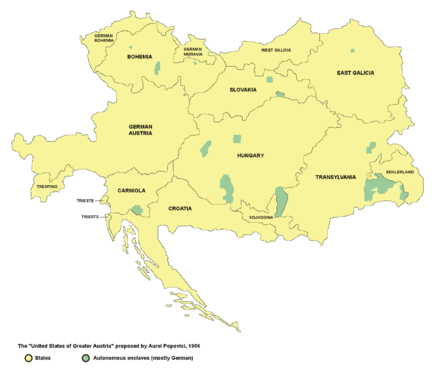
Historians have disagreed on how to characterize the political philosophies of Franz Ferdinand, some attributing generally liberal views on the empire's nationalities while others have emphasized his dynastic centralism, Catholic conservatism, and tendency to clash with other leaders.[15] He advocated granting greater autonomy to ethnic groups within the Empire and addressing their grievances, especially the Czechs in Bohemia and the south Slavic peoples in Croatia and Bosnia, who had been left out of the Austro-Hungarian Compromise of 1867.[28] Yet his feelings towards the Hungarians were less generous, often described as antipathy. For example, in 1904 he wrote that "The Hungarians are all rabble, regardless of whether they are minister or duke, cardinal or burgher, peasant, hussar, domestic servant, or revolutionary" and he regarded even István Tisza as a revolutionary and "patented traitor".[29] He regarded Hungarian nationalism as a revolutionary threat to the Habsburg dynasty and reportedly became angry when officers of the 9th Hussars Regiment (which he commanded) spoke Hungarian in his presence — despite the fact that it was the official regimental language.[16] He further regarded the Hungarian branch of the Dual Monarchy's army, the Honvédség, as an unreliable and potentially threatening force within the empire, complaining at the Hungarians' failure to provide funds for the joint army[30] and opposing the formation of artillery units within the Hungarian forces.[31]
He also advocated a careful approach towards Serbia – repeatedly locking horns with Franz Conrad von Hötzendorf, Vienna's hard-line Chief of the General Staff, warning that harsh treatment of Serbia would bring Austria-Hungary into open conflict with Russia, to the ruin of both Empires.
He was disappointed when Austria-Hungary failed to act as a Great Power, such as during the Boxer Rebellion, in 1900. Other nations, including, in his description, "dwarf states like Belgium and Portugal",[18] had soldiers stationed in China, but Austria-Hungary did not. However, Austria-Hungary did participate in the Eight-Nation Alliance to suppress the Boxers, and sent soldiers as part of the "international relief force".
Franz Ferdinand was a prominent and influential supporter of the Austro-Hungarian Navy in a time when sea power was not a priority in Austrian foreign policy and the Navy was relatively little known and supported by the public. After his assassination in 1914, the Navy honoured Franz Ferdinand and his wife with a lying in state aboard SMS Viribus Unitis.
Assassination


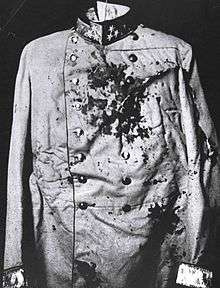
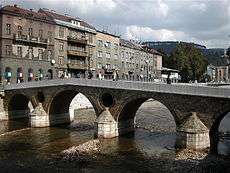
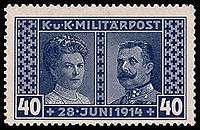
On Sunday, 28 June 1914, at about 10:45 am, Franz Ferdinand and his wife were killed in Sarajevo, the capital of the Austro-Hungarian province of Bosnia and Herzegovina, by Gavrilo Princip, 19 at the time, a member of Young Bosnia and one of a group of assassins organized and armed by the Black Hand.[4] The event led to a chain of events that eventually triggered World War I.
Earlier in the day, the couple had been attacked by Nedeljko Čabrinović, who had thrown a grenade at their car. However, the bomb detonated behind them, hurting the occupants in the following car. On arriving at the Governor's residence, Franz angrily shouted, "So this is how you welcome your guests — with bombs?!"[32]
After a short rest at the Governor's residence, the royal couple insisted on seeing all those who had been injured by the bomb at the local hospital. However, no one told the drivers that the itinerary had been changed. When the error was discovered, the drivers had to turn around. As the cars backed down the street and onto a side street, the line of cars stalled. At this same time, Princip was sitting at a cafe across the street. He instantly seized his opportunity and walked across the street and shot the royal couple.[32] He first shot Sophie in the abdomen and then shot Franz Ferdinand in the neck. Franz leaned over his crying wife. He was still alive when witnesses arrived to render aid.[4] His dying words to Sophie were, 'Don't die darling, live for our children.'[32] Princip's weapon was the pocket-sized FN Model 1910 pistol chambered for the .380 ACP cartridge provided him by Serbian Army Colonel and Black Hand member Dragutin Dimitrijević.[33] The archduke's aides attempted to undo his coat but realized they needed scissors to cut it open: the outer lapel had been sewn to the inner front of the jacket for a smoother fit to improve the Archduke's appearance to the public. Whether or not as a result of this obstacle, the Archduke's wound could not be attended to in time to save him, and he died within minutes. Sophie also died en route to the hospital.[34]
A detailed account of the shooting can be found in Sarajevo by Joachim Remak:[35]
One bullet pierced Franz Ferdinand's neck while the other pierced Sophie's abdomen. ... As the car was reversing (to go back to the Governor's residence because the entourage thought the Imperial couple were unhurt) a thin streak of blood shot from the Archduke's mouth onto Count Harrach's right cheek (he was standing on the car's running board). Harrach drew out a handkerchief to still the gushing blood. The Duchess, seeing this, called: "For Heaven's sake! What happened to you?" and sank from her seat, her face falling between her husband's knees.
Harrach and Potoriek ... thought she had fainted ... only her husband seemed to have an instinct for what was happening. Turning to his wife despite the bullet in his neck, Franz Ferdinand pleaded: "Sopherl! Sopherl! Sterbe nicht! Bleibe am Leben für unsere Kinder! – Sophie dear! Don't die! Stay alive for our children!" Having said this, he seemed to sag down himself. His plumed hat ... fell off; many of its green feathers were found all over the car floor. Count Harrach seized the Archduke by the uniform collar to hold him up. He asked "Leiden Eure Kaiserliche Hoheit sehr? – Is Your Imperial Highness suffering very badly?" "Es ist nichts. – It is nothing." said the Archduke in a weak but audible voice. He seemed to be losing consciousness during his last few minutes, but, his voice growing steadily weaker, he repeated the phrase perhaps six or seven times more.
A rattle began to issue from his throat, which subsided as the car drew in front of the Konak bersibin (Town Hall). Despite several doctors' efforts, the Archduke died shortly after being carried into the building while his beloved wife was almost certainly dead from internal bleeding before the motorcade reached the Konak.
The assassinations, along with the arms race, nationalism, imperialism, militarism, and the alliance system all contributed to the origins of World War I, which began a month after Franz Ferdinand's death, with Austria-Hungary's declaration of war against Serbia.[36] The assassination of Ferdinand is considered the most immediate cause of World War I.[37]
Franz Ferdinand is interred with his wife Sophie in Artstetten Castle, Austria.
Honours and awards
Austro-Hungarian
- Knight of the Order of the Golden Fleece
- Grand Cross of the Order of Saint Stephen of Hungary
Foreign
Among other orders, he held the following[38]
.svg.png) Russian Empire : Knight of the Order of St. Andrew
Russian Empire : Knight of the Order of St. Andrew.svg.png) Russian Empire : Knight of the Order of Saint Alexander Nevsky
Russian Empire : Knight of the Order of Saint Alexander Nevsky.svg.png) Russian Empire : Knight of the Order of St. Anna
Russian Empire : Knight of the Order of St. Anna.svg.png) Russian Empire : Knight (first class) of the Order of Saint Stanislaus
Russian Empire : Knight (first class) of the Order of Saint Stanislaus Congress Poland : Knight of the Order of the White Eagle
Congress Poland : Knight of the Order of the White Eagle United Kingdom : Knight of the Order of the Garter - 15 July 1902[39]
United Kingdom : Knight of the Order of the Garter - 15 July 1902[39] United Kingdom : Knight Grand Cross of the Order of the Bath
United Kingdom : Knight Grand Cross of the Order of the Bath.svg.png) Kingdom of Prussia : Knight of the Order of the Black Eagle
Kingdom of Prussia : Knight of the Order of the Black Eagle_crowned.svg.png) Kingdom of Italy : Knight of the Order of the Most Holy Annunciation
Kingdom of Italy : Knight of the Order of the Most Holy Annunciation Denmark : Knight of the Order of the Elephant
Denmark : Knight of the Order of the Elephant.svg.png) Spain : Knight of the Order of Charles III
Spain : Knight of the Order of Charles III Japan : Grand Cross of the Order of the Chrysanthemum
Japan : Grand Cross of the Order of the Chrysanthemum
Commemorations

Archduke Franz Ferdinand and his Castle of Artstetten were selected as a main motif for the Austrian 10 euro The Castle of Artstetten commemorative coin, minted on 13 October 2004. The reverse shows the entrance to the crypt of the Hohenberg family. There are two portraits below, showing Archduke Franz Ferdinand and his wife Sophie, Duchess of Hohenberg.[40]
The Scottish band Franz Ferdinand named themselves after him.[41]
See also
Ancestry
References
Notes
- ↑ Brook-Shepherd, Gordon (1987). Royal Sunset: The European Dynasties and the Great War. Doubleday. p. 139. ISBN 978-0-385-19849-3.
- ↑ Marshall, S.L.A. (2001). World War I. Mariner Books. p. 1. ISBN 0-618-05686-6.
- ↑ Keegan, John (2000). The First World War. Vintage. p. 48. ISBN 0-375-70045-5.
- 1 2 3 Johnson, Lonnie (1989). Introducing Austria: A Short History (Studies in Austrian Literature, Culture, and Thought). Ariadne Press. pp. 52–54. ISBN 0-929497-03-1.
- 1 2 3 Brook-Shepherd, Gordon (1997). The Austrians: A Thousand-Years Odyssey. Carroll & Graf. pp. 107, 125–126. ISBN 0-7867-0520-5.
- ↑ "The Crown Prince's Successor". The New York Times. 2 February 1889. Accessed 22 May 2009.
- ↑ "The Archduke Franz Ferdinand". The Argus (Australia). 23 May 1895. Accessed 28 June 2010
- ↑ Australian Town and Country Journal, 15 April 1893, p. 29; Retrieved 2 September 2013
- ↑ Katalog Land in Sicht!: Österreich auf weiter Fahrt (Catalogue Land Ahoy!: Austria on the Seven Seas) (in PDF and in German language) p. 8. Exhibition by the Austrian Mint, 17 August - 3 February 2006. Münze Österreich (Austrian Mint). Accessed 22 May 2009.
- ↑ Watson, Greig. "Could Franz Ferdinand Welbeck gun accident have halted WWI?". BBC News.
- ↑ Wladimir Aichelburg, Erzherzog Franz Ferdinand von Österreich-Este und Artstetten, Vienna: Lehner, 2000, ISBN 978-3-901749-18-6, p. 31 (in German): "Tatsächlich war Franz Ferdinand ein außergewöhnlich leidenschaftlicher Jäger" - "It is a fact that Franz Ferdinand was an unusually passionate hunter."
- ↑ Michael Hainisch, ed. Friedrich Weissensteiner, 75 Jahre aus bewegter Zeit: Lebenserinnerungen eines österreichischen Staatsmannes, Veröffentlichungen der Kommission für neuere Geschichte Österreichs 64, Vienna: Böhlau, 1978, ISBN 978-3-205-08565-2, p. 367 (in German): "Konopischt ... das einst dem Erzherzoge Franz Ferdinand gehört hatte. Das Schloß ist voller Jagdtrophäen" - "Konopiště ... which once belonged to Archduke Franz Ferdinand. The castle is full of hunting trophies."
- ↑ Neil Wilson and Mark Baker, Prague: City Guide, Lonely Planet City Guide, 9th ed. Footscray, Victoria / Oakland, California / London: Lonely Planet, 2010, ISBN 978-1-74179-668-1, p. 237.
- ↑ Thomas Veszelits, Prag, HB-Bildatlas 248, Ostfildern: HB, 2003, ISBN 978-3-616-06152-8, p. 106. (in German): "Jagdtrophäen, Waffen aus drei Jahrhunderten und Kunstschätze füllten die Räume" – "Hunting trophies, weapons dating to three centuries, and art treasures filled the rooms."
- 1 2 Rothenburg, G. The Army of Francis Joseph. West Lafayette: Purdue University Press, 1976. p 141.
- 1 2 Rothenburg 1976, p. 120.
- 1 2 Rothenburg 1976, p. 141.
- 1 2 Rothenburg 1976, p. 136.
- ↑ Rothenburg 1976, p. 170.
- 1 2 3 Meyer, G. J. (2007). A World Undone: The Story of the Great War 1914 to 1918. Bantam Dell. p. 5. ISBN 978-0-553-38240-2.
- ↑ Schwarz, Otto. Hinter den Fassaden der Ringstrasse: Geschichte, Menschen, Geheimnisse. Amalthea, Vienna, 2007, ISBN 978-3-85002-589-8, p. 26 (in German)
- ↑ The Family Crypt Archived August 21, 2011, at the Wayback Machine., Artstetten Castle.
- ↑ Freund, Michael: Deutsche Geschichte. Die Große Bertelsmann Lexikon-Bibliothek, Bd. 7. C. Bertelsmann Verlag, 1961. p.901
- ↑ Die Fackel. Issue July 10, 1914
- ↑ Ketterl, Eugen. Der alte Kaiser wie nur einer ihn sah. Cissy Klastersky (ed.), Gerold & Co., Vienna 1929
- ↑ Brückler, Theodor: Franz Ferdinand als Denkmalpfleger. Die "Kunstakten" der Militärkanzlei im Österreichischen Staatsarchiv. Böhlau Verlag, Vienna 2009. ISBN 978-3-205-78306-0
- ↑ Valiani, Leo, The End of Austria-Hungary, Alfred A. Knopf, New York (1973) pp. 9–10 [translation of: La Dissoluzione dell'Austria-Ungheria, Casa Editrice Il Saggiatore, Milano (1966) pp. 19–20]
- ↑ Morton, Frederick (1989). Thunder at Twilight: Vienna 1913/1914. Scribner. p. 191. ISBN 978-0-684-19143-0.
- ↑ Köpeczi, Béla (General Editor); Szász, Zoltán (Editor) (1994). History of Transylvania. Budapest: Akadémiai Kiadó. ISBN 963-05-6703-2.
- ↑ Rothenburg 1976, p. 147.
- ↑ Rothenburg 1976, p. 133.
- 1 2 3 Beyer, Rick, The Greatest Stories Never Told, A&E Television Networks / The History Channel, ISBN 0-06-001401-6. p. 146–147
- ↑ Belfield, Richard. The Assassination Business: A History of State-Sponsored Murder. Carroll & Graf. ISBN 978-0-7867-1343-1.
- ↑ MacDonogh, Giles (2003). The Last Kaiser: The Life of Wilhelm II. St. Martin's Griffin. p. 351. ISBN 978-0-312-30557-4.
- ↑ Remak, Joachim (1959). Sarajevo: The Story of a Political Murder. Criterion. pp. 137–142. ASIN B001L4NB5U.(ASIN B001L4NB5U)
- ↑ Johnson. p. 56
- ↑ John McCannon, PhD. - AP World History - Copyright 2010, 2008, Barron's Educational Series, Inc. - page 9.
- ↑ http://alex.onb.ac.at/cgi-content/alex?aid=shb&datum=1914&page=22&size=45
- ↑ "No. 27454". The London Gazette. 15 July 1902. p. 4509.
- ↑ Austrian 10-Euro Coins. Austriancoins.com (2002-10-09). Retrieved on 2013-08-16.
- ↑ How Franz Ferdinand & Kasabian Got Their Band Names???. FeelNumb.com. Retrieved on 2013-08-16.
External links
| Wikimedia Commons has media related to Archduke Franz Ferdinand of Austria. |
| Wikiquote has quotations related to: Archduke Franz Ferdinand of Austria |
- Archduke Franz Ferdinand d'Este (in Czech language)
- Archduke Franz Ferdinand of Austria at Find a Grave
- Video: Franz Ferdinand's Funeral on YouTube
- Newsreels about Franz Ferdinand's assassination at www.europeanfilmgateway.eu
 Pribram, Alfred Francis (1922). "Francis Ferdinand". Encyclopædia Britannica (12th ed.).
Pribram, Alfred Francis (1922). "Francis Ferdinand". Encyclopædia Britannica (12th ed.).
| Archduke Franz Ferdinand of Austria Cadet branch of the House of Lorraine Born: 18 December 1863 Died: 28 June 1914 | ||
| Royal titles | ||
|---|---|---|
| Preceded by Francis II |
Archduke of Austria-Este 1875–1914 |
Succeeded by Charles |
| Titles in pretence | ||
| Preceded by Francis V |
— TITULAR — Duke of Modena 1875–1914 |
Succeeded by Charles |
